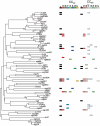Recombination drives genetic diversification of Streptococcus dysgalactiae subspecies equisimilis in a region of streptococcal endemicity
- PMID: 21857905
- PMCID: PMC3153926
- DOI: 10.1371/journal.pone.0021346
Recombination drives genetic diversification of Streptococcus dysgalactiae subspecies equisimilis in a region of streptococcal endemicity
Erratum in
- PLoS One. 2012;7(4): doi/10.1371/annotation/fbdb6697-5b22-4ac5-b38a-b55fc6f86beb
Abstract
Infection of the skin or throat by Streptococcus dysgalactiae subspecies equisimilis (SDSE) may result in a number of human diseases. To understand mechanisms that give rise to new genetic variants in this species, we used multi-locus sequence typing (MLST) to characterise relationships in the SDSE population from India, a country where streptococcal disease is endemic. The study revealed Indian SDSE isolates have sequence types (STs) predominantly different to those reported from other regions of the world. Emm-ST combinations in India are also largely unique. Split decomposition analysis, the presence of emm-types in unrelated clonal complexes, and analysis of phylogenetic trees based on concatenated sequences all reveal an extensive history of recombination within the population. The ratio of recombination to mutation (r/m) events (11:1) and per site r/m ratio (41:1) in this population is twice as high as reported for SDSE from non-endemic regions. Recombination involving the emm-gene is also more frequent than recombination involving housekeeping genes, consistent with diversification of M proteins offering selective advantages to the pathogen. Our data demonstrate that genetic recombination in endemic regions is more frequent than non-endemic regions, and gives rise to novel local SDSE variants, some of which may have increased fitness or pathogenic potential.
Conflict of interest statement
Figures




Similar articles
-
Population genetics of Streptococcus dysgalactiae subspecies equisimilis reveals widely dispersed clones and extensive recombination.PLoS One. 2010 Jul 23;5(7):e11741. doi: 10.1371/journal.pone.0011741. PLoS One. 2010. PMID: 20668530 Free PMC article.
-
Genetic relationships deduced from emm and multilocus sequence typing of invasive Streptococcus dysgalactiae subsp. equisimilis and S. canis recovered from isolates collected in the United States.J Clin Microbiol. 2009 Jul;47(7):2046-54. doi: 10.1128/JCM.00246-09. Epub 2009 Apr 22. J Clin Microbiol. 2009. PMID: 19386831 Free PMC article.
-
Distribution of virulence factors and association with emm polymorphism or isolation site among beta-hemolytic group G Streptococcus dysgalactiae subspecies equisimilis.APMIS. 2015 Jan;123(1):45-52. doi: 10.1111/apm.12305. Epub 2014 Sep 22. APMIS. 2015. PMID: 25244428
-
Exploring the necessity of molecular detection for Streptococcus dysgalactiae subsp equisimilis: Often misdiagnosed, and emerging pathogen.Indian J Med Microbiol. 2024 Nov-Dec;52:100744. doi: 10.1016/j.ijmmb.2024.100744. Epub 2024 Nov 21. Indian J Med Microbiol. 2024. PMID: 39414075 Review.
-
Severe invasive streptococcal infection by Streptococcus pyogenes and Streptococcus dysgalactiae subsp. equisimilis.Microbiol Immunol. 2016 Jan;60(1):1-9. doi: 10.1111/1348-0421.12334. Microbiol Immunol. 2016. PMID: 26762200 Review.
Cited by
-
First report on a foodborne outbreak of Streptococcus dysgalactiae Subsp. equisimilis in China.J Health Popul Nutr. 2025 Jun 15;44(1):201. doi: 10.1186/s41043-025-00957-5. J Health Popul Nutr. 2025. PMID: 40518513 Free PMC article.
-
Horizontal gene transfer and recombination in Streptococcus dysgalactiae subsp. equisimilis.Front Microbiol. 2014 Dec 15;5:676. doi: 10.3389/fmicb.2014.00676. eCollection 2014. Front Microbiol. 2014. PMID: 25566202 Free PMC article.
-
Molecular subtyping and antimicrobial susceptibility of Streptococcus dysgalactiae subspecies equisimilis isolates from clinically diseased pigs.J Vet Sci. 2020 Jul;21(4):e57. doi: 10.4142/jvs.2020.21.e57. J Vet Sci. 2020. PMID: 32735095 Free PMC article.
-
Genomic epidemiology of Streptococcus dysgalactiae subsp. equisimilis strains causing invasive disease in Norway during 2018.Front Microbiol. 2023 Apr 17;14:1171913. doi: 10.3389/fmicb.2023.1171913. eCollection 2023. Front Microbiol. 2023. PMID: 37485526 Free PMC article.
-
Inter-species gene flow drives ongoing evolution of Streptococcus pyogenes and Streptococcus dysgalactiae subsp. equisimilis.Nat Commun. 2024 Mar 13;15(1):2286. doi: 10.1038/s41467-024-46530-2. Nat Commun. 2024. PMID: 38480728 Free PMC article.
References
-
- Carapetis JR, Steer AC, Mulholland EK, Weber M. The global burden of group A streptococcal diseases. Lancet Infect Dis. 2005;5:685–694. - PubMed
-
- Efstratiou A. Pyogenic streptococci of Lancefield groups C and G as pathogens in man. Soc Appl Bacteriol Symp Ser. 1997;26:72S–79S. - PubMed
-
- Brandt CM, Spellerberg B. Human infections due to Streptococcus dysgalactiae subspecies equisimilis. Clin Infect Dis. 2009;49:766–772. - PubMed
-
- Broyles LN, Van Beneden C, Beall B, Facklam R, Shewmaker PL, et al. Population-based study of invasive disease due to beta-hemolytic streptococci of groups other than A and B. Clin Infect Dis. 2009;48:706–712. - PubMed
Publication types
MeSH terms
Substances
LinkOut - more resources
Full Text Sources
Medical

